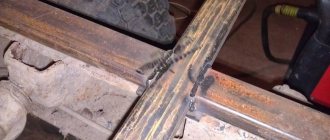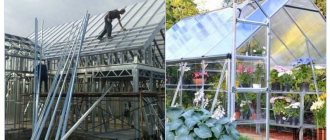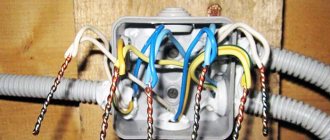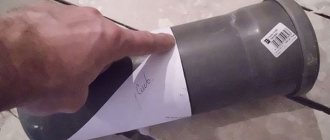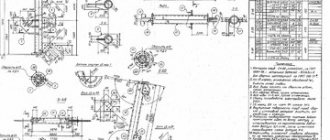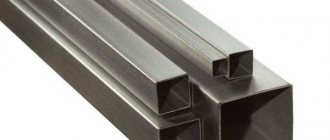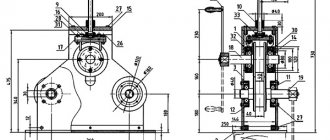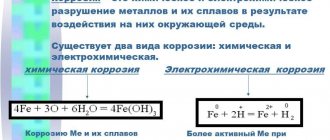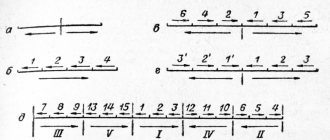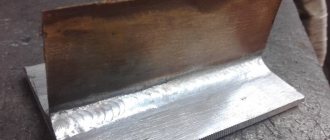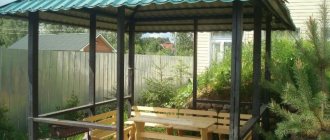During the production of light metal structures, profile pipes are widely used. It is used to create metal frames for canopies, fences, canopies, greenhouses, small architectural forms, including gazebos, benches, and so on. When manufacturing structures, welding of a profile pipe is often carried out. It will be useful to know the specifics of this process. Let's look at the basics and methods of welding corrugated pipes, the electrodes used, the nuances of welding at an angle of 90°, without burning through and connecting to a round post.
Welding process for profiled pipes Source sinhala.news.lk
Basics of welding corrugated pipes
Profiled pipes are produced with walls of different thicknesses. At the same time, it is most difficult to work with thin-walled rolled metal. To perform the welding process efficiently, you need to have knowledge and experience. Therefore, it is necessary to understand how thin-walled pipes are welded. During this process:
- current used is 10-60 A;
- electrodes with a diameter of 0.5-2 mm are used;
- Only one pass of the electrode is carried out at the junction of the parts.
Welding speed affects the quality of the seam. The process must be completed before the edges of the two workpieces being joined cool down.
Important! Rutile electrodes allow for pull-out welding.
Electrodes with rutile coating Source temir.ru
To make quality connections, you also need to know how to properly weld a profile pipe, regardless of the wall thickness. When carrying out such welding work, it is necessary to take into account that during the process the metal melts and often fills or even completely covers the internal space of the pipe. If it is necessary to maintain the hollowness of the corrugated pipes, it is necessary to ensure that drops do not fall into the internal cavities of the parts being welded.
In addition, profiled pipes are more deformed when exposed to high temperatures compared to similar round products. It is also necessary to ensure the correct formation of the weld bead and evenly heat the metal while making end connections to prevent the appearance of high stress in the corners.
General information
Welded structures made from this material are lightweight and also have fairly high strength indicators. It is obtained from an ordinary pipe by plastic deformation, in a hot or cold state. The most commonly used profile has a square or rectangular cross-section. The vast majority of it is made from low-carbon steel.
Low-alloy and stainless steels are used on a much smaller scale, due to the high price of the resulting structure.
For beginners, welding a profile pipe with an inverter is often a problem, especially if the wall thickness is 1.5-2 mm.
A welding helmet is one piece of welding equipment that you should not skimp on if you are going to be a skilled welder and preserve your vision. A good mask with a substitute will serve you for many years.
The sales consultant in the store will help you with the right choice. It's better to pay a little more and get the Maxa Chameleon, which automatically dims. This is convenient; you can see where the electrode is before welding begins. A regular mask with a dark glass filter will not provide this opportunity. Another advantage of the chameleon is that you can beat off slag without a shield. The mask itself will be used instead.
When performing welding work, you will need auxiliary tools and materials.
Welding methods
Professionals know well how to weld a profile pipe using different methods. Therefore, they quickly and efficiently complete the assigned tasks.
Manual arc welding
This method is often used by specialists. This method is easy to implement. It allows you to get a high-quality seam using available equipment.
Seam after manual arc welding Source content.foto.my.mail.ru
To perform the process, specialists use an inverter or transformer welding machine. To increase the convenience of work, various devices can be additionally used. One of them is magnetic squares. With their help, it is more convenient to weld pipe blanks at the desired angle.
Often specialists also use centralizers. With their help, it is possible to quickly align the axes of the parts when they are connected at the ends. External and internal centralizers are used. One of the varieties are clamps, which allow you to rigidly secure products on a flat surface.
Manual arc welding is used to connect profiled pipe parts with different section sizes and wall thicknesses. If corrugated pipes are made of metal thicker than 4 mm, then their ends are first cleaned and then degreased.
In addition, you also need to know which electrodes to use to weld the profile pipe in order to obtain a strong connection. If the wall thickness does not exceed 4 mm, then rods with a diameter of 2 to 3 mm are used. In this case, the current strength on the welding machine is set in the range from 50 A to 60 A.
Welding electrodes 2.5 mm Source main-cdn.goods.ru
Important! When welding thin-walled corrugated pipes, there is no need to pre-form the edges. In this case, it is necessary to maintain a minimum gap between the parts. Welding processes using the manual arc method are carried out vertically, horizontally and even in the down position.
See also: Catalog of companies that specialize in complex installation of internal engineering systems
Electric arc welding process in shielding gas
Connecting a professional pipe in this way is done using non-consumable electrodes. The method is used for welding thin-walled parts that are pre-cleaned and degreased.
To carry out the process correctly, you also need to know which electrodes to use to weld a 2 mm profile pipe. When connecting such rolled products, tungsten rods are used. Their diameter should be 1 mm. If the wall thickness of rolled metal exceeds 2 mm, then electrodes with a cross-sectional size of 1.6 mm are used.
You also need to choose the correct diameter of the welding wire. This characteristic also depends on the thickness of the metal. If it is 1 mm, then use wire with a diameter of 1 mm to 1.5 mm. When the wall thickness of the corrugated pipe is 2 mm, wire is used whose cross-sectional size ranges from 2 mm to 2.5 mm.
Welding wire for professional pipes Source tck-market.ru
When performing the process itself, professionals hold the electrode at a minimum distance from the welding site. This allows you to create the shortest possible arc, which improves penetration and improves the quality of the welded joint. The electrode is moved only in the direction of the seam. At the same time, they do not make transverse movements.
Important! The supply of filler material is smooth. Otherwise, splashing will occur. In this case, the maximum amount of gas consumed should be 12 l/min.
It is also important to correctly set the current strength when performing electric arc welding of a profile in shielding gas. Its value should be 50-120 A. The choice of value is influenced by the thickness of the metal.
When performing the electric arc welding process in shielding gas, specialists use:
- block and transformer or inverter power source;
- gas burner;
- gas cylinder;
- special rubber hoses;
- gearbox
Equipment for the electric arc welding process Source 8.allegroimg.com
When completing the electric arc welding process, first reduce the voltage. In this case, the gas is not shut off immediately, but only after 15 seconds after turning off the current.
Welding process
The welding process when manufacturing stainless steel products, as in the case of welding other metals, is divided into three stages - the preparatory stage, the welding stage itself and the final stage.
Preparation stage
At the preparatory stage, you should mark the parts that are planned to be welded, clean them, and degrease them using a special chemical composition. If this is dictated by the thickness of the parts being joined, it will also be necessary to cut the edges for better formation of the weld seam.
Main works
The main welding stage consists of the following steps:
- connecting the inverter by creating reverse polarity (the cable with the electrode holder is connected to the “+” connector, and the ground cable is connected to the “-” connector). Such a connection will ensure greater melting of the electrode compared to a connection in direct mode, as well as avoid burning through the material by reducing the penetration of parts;
- After the parts are secured in the positions in which they will be welded, primary tack welds should be made. The length of such seams and their location along the contour of the planned weld is determined depending on the size of the seam, as well as depending on the thickness of the parts being welded;
- in the event that we are talking about creating a long-length welding seam, a stepwise method should be performed, during which welding is carried out from opposite sides with short seams;
- if it is necessary to perform several layers in one seam, then after each new layer you should wait some time so that the previous layer has time to cool before applying a new one;
- in the case of a large seam (extended in distance) or if it has a complex configuration, it will be necessary to make a larger number of tacks compared to simple or short seams, each of which will differ in a short length, located along the edges of the seam. This action will reduce the risk of deformation of parts near the seam.
Final stage
After the welding work is completed, you should move on to the final stage. At this stage, the seam is cleaned of the formed slag in order to determine its quality visually. In addition, at this stage the identification of places where there are lack of penetration occurs. If such places are found, repairs should be made or the joint should be completely cut out and welded, repeating the entire algorithm.
Video description
The technology of DC welding is described in the video:
The inverter allows you to weld pipes with different wall thicknesses. The equipment is ideal for beginner welders. After all, such modern devices have a pulse mode of operation.
When welding a 2 mm profile pipe with an inverter, the current strength is set in the range from 50 A to 60 A. If thick-walled rolled products are connected, then the craftsmen increase the electric current.
When the electrode makes contact, an electric arc occurs. Coated rods are used in this work. It begins to burn when the arc is excited. As a result, the coating melts. One part of it moves onto the molten metal, and the other goes into a gas state. Therefore, the working area does not come into contact with air.
Welding using an inverter prevents the electrode rod from sticking. In this case, the process is performed with a stable arc, since the equipment used is a source of direct current. This results in a high-quality weld.
Weld from inverter Source instructables.com
Difficulty in selecting electrodes
, various methods of joining metals are used for welding profile pipes . Each of them uses different consumables . When using, for example, manual arc welding, it is necessary to make the right choice from a huge number of brands of electrodes. The presence of consumables with different protective coatings further complicates the selection of electrodes to obtain a high-quality seam. It is important to know that some of them are more suitable for beginners , while other brands are preferred by experienced welders . These factors are discussed in more detail in the following sections of the article.
Common electrodes for welding corrugated pipes
In the production of profile pipes, low-alloy or carbon steel is often used. Such rolled metal is welded using the following electrodes:
- ANO-4 is a popular brand of electrode rods. This is a universal consumable that does not require pre-calcination. This type of electrode is used with various types of welding machines.
- OZS-12 – rods are designed to produce high-quality seams. However, the disadvantage is low resistance to moisture.
- UONI-13/55 – these rods are used by a large number of professionals.
- MP-3S - these electrodes are used when it is necessary to improve the quality properties of welds.
Popular manufacturers
In the domestic market of welding consumables, there is competition among Russian, global, Chinese and Belarusian manufacturers.
The TOP Russian manufacturers include (electrodes are produced under the Spetselektrod trademark), JSC Elektrodny, JSC Penza Electrodes, LLC Zelenograd Electrode Plant and others.
Electrodes ELZ-52U, which are an analogue of Japanese consumables, from a large Russian manufacturer - JSC Electrode Plant
Among the world's electrode manufacturers, ESAB, KOBE STEEL, CAPILLA, RESANTA and others are popular.
Chinese manufacturers producing inexpensive but high-quality electrodes “GOLDEN BRIDGE”, “ELKRAFT”, “JASIK” and others on the Russian market.
Popular among Russian welders are electrodes produced in Belarus by Svetlogorsk Welding Electrode Plant LLC (trademarks Monolit, Arsenal), and Vatra LLC.
Features of welding profile pipes at an angle of 90°
Only a specialist will be able to qualitatively connect two parts from rolled pipe at right angles. After all, he has experience and knows all the technology on how to weld a profile pipe at 90 degrees. The professional performs the process in the following sequence:
- both pipes are cut in accordance with the calculated dimensions;
- a flat surface is selected and prepared for work;
- the right angle between two parts is fixed using magnetic squares or scarves;
- a rough connection is made by welding;
- the right angle between the two pipes is checked;
- final welding of rolled metal is carried out.
Welding thin metal in argon.
Argon welding of thin stainless steel parts very often occurs using this welding method. Inert gas – argon provides a high degree of protection.
To perform welding, as in previous methods, we prepare the equipment:
- Check the integrity of electrical cables.
- Connect gas equipment to the welding machine.
- Connect the burner and the ground cable to the device.
- Turn on the welding machine.
- Set the mode.
- Purge the gas line.
Setting up a welding inverter for welding in argon.
For argon arc welding of thin metal, straight polarity is used.
After setting the welding parameters, we move on to the technology itself. As in the previous methods, we adjust the welding current on a separate workpiece. Taking data from tables as a basis. Gas flow is also adjusted. It is worth considering that if the process is carried out in windy conditions, it is necessary to use a nozzle with a larger diameter, as well as increase gas consumption. At the same time, bring the torch as close as possible to the weld pool.
Preparation for welding:
- The welding wire must be cleaned of rust and calcined for 1.5-2 hours at a temperature of 150 to 280 °C.
- The edges of the product must be cleaned 20-30 mm from the joint to a metallic shine and degreased.
We install potholders.
They need to be placed at a distance of 5-10 mm from the edge with a step between tacks of 200-250 mm.
You need to start cooking on an oven mitt. Both edges and additives are heated. It is necessary to cook at an angle forward with the shortest possible arc. This provides high protection for the molten metal. The additive is supplied to the weld pool area. Do not oscillate the burner. After the process is completed and the arc breaks, gas must be supplied for 10-15 seconds.
If you are going to weld a thin stainless steel part with argon, then additional conditions must be observed:
- Minimum arc length. To ensure high quality protection.
- Do not oscillate the torch in the transverse direction.
- Maximum execution speed.
- Minimum welding current.
These measures will reduce overheating of the metal. And as a result, they will help to avoid hot cracks.
In this article we introduced you to the main methods of welding thin metal.
Undoubtedly, the leader at home is MAR - manual arc welding. Although, of course, non-consumable electrode and semi-automatic (mag) welding are much better suited. Good luck in the practical application of the material.
Welding without burning through a profile pipe
Most often, thin-walled pipe metal is burned through. The reason for this unpleasant situation may be the wrong choice of welding method. You can prevent any mistake if you entrust the work to professionals. After all, they know well how to properly weld a profile pipe so as not to burn through the junction of two parts.
To minimize the likelihood of burning through thin-walled metal, electrodes with a diameter of no more than 1.5 mm are used. In this case, be sure to set a small amount of electric current on the welding machine and select reverse polarity.
It is also recommended to carry out the process with separation. In other words, welding should be done in short sections. It can also be done using the point method. In addition, it is better to insert a metal liner into the pipes, the external dimensions of which are as close as possible to the internal size of the elements being connected.
They also try to minimize the distance between the edges of welded profile pipes. In this case, they strive to move the electrode rod as quickly as possible.
How to avoid profile burning
How to avoid burning a profile pipe when welding video
Burning is most likely when working with a profile with thin walls. You can reduce the likelihood of a defect by choosing the right electrode. Its diameter should be up to 1.5 mm. The current should be minimal and the polarity of the connection reversed.
The following tips will help you avoid burning:
- The arc should be ignited on a tack;
- The electrode is placed at an angle back and passed over the junction at a distance of 10-15 mm;
- The arc is formed so that it is shorter;
- Oscillatory movements are excluded;
- They break the arc not at the end of the joint, but by going back 15-20 mm;
- Splashes from the melt and slag must be removed immediately.
During welding, you must always comply with all technological requirements and choose the right consumables; this approach significantly increases the chances of a perfect connection of the most complex workpieces.
Errors when welding profile pipes video
Welded connection of a professional pipe with a round table
The need to use welding when connecting logs from a profile pipe to metal posts arises when constructing a fence along the perimeter of a private territory. In the process of erecting a fence, a number of issues are resolved. A reliable fence will always be built by specialists. After all, they know well how to weld a 40x20 profile pipe to a round post.
Typically, metal pads are first welded onto supports with a circular cross-section. This can be a section of a channel or corner. Then a cross member made of corrugated pipe is attached to them by welding. During fixation of the lag, corner seams are created. The peculiarity of their execution in the horizontal direction is that the molten metal tends to move from the pillar to the crossbar.
When connecting the support and the cross member, it will not be possible to use the “boat” welding method, because the logs are attached exclusively in the horizontal plane. In this case, the pillars are always placed vertically. Therefore, they cannot be placed in a different position to prevent slag from flowing in front of the arc.
Welding fillet welds using the “boat” method Source ds04.infourok.ru
When creating a fillet weld, there is a high probability of lack of penetration. It can occur at the apex of a corner or on any edge. An unwelded area often appears on a profile pipe when the welding process begins with a vertical support. It is formed due to the flow of molten metal onto the surface of the cross member, which has not yet had time to heat up to the required temperature.
To eliminate the possibility of lack of penetration, specialists begin welding from the log. In this case, the electrode is placed at an angle of 45° relative to the crossbar, and during its movement, slight alternating tilts are made to the vertical and horizontal planes.
Welding a frame made of a profile pipe and round metal posts in this way allows you to create strong seams. They can be single or multi-layered.
Welding a profile pipe to a round post Source stevesiron.com
Which consumables are best to choose?
There are four main types of electrode coatings, which affect the mechanical characteristics of the seam, the protective functions of the welding zone and ensure the stable functioning of the welding arc:
- sour;
- cellulose;
- rutile;
- basic.
Coated electrode for electric arc welding
In addition to the main ones, mixed coatings are used, which have the characteristics of both types included in the coating: acid-rutile, rutile-basic, rutile-cellulose.
All of these coatings, to a greater or lesser extent, perform their functions when welding low-carbon steels, which are mainly used for the production of profile pipes.
Electrodes with an acidic coating during operation are characterized by increased splashing and the release of toxic substances. The risk of hot cracks cannot be ruled out . For structures made of profile pipes, which are subject to strict requirements for ensuring strength characteristics, and in some cases there are decorative functions, the use of welding with acid-coated electrodes is not recommended.
Heavy splashes and the presence of hydrogen in the weld, which reduces its ductility, are the main disadvantages when welding with cellulose-coated electrodes. A frame made of profile pipes welded with such electrodes may collapse over time due to hydrogen embrittlement of the welds.
Electrodes LB-52U with the main type of coating ensure a high-quality seam when working with corrugated pipes
Electrodes with a basic coating are characterized by high ductility and good toughness. The seam does not contain hydrogen and other gases and impurities, which eliminates the formation of cold cracks . High requirements for the preparation of welded edges (absence of moisture, rust and other contaminants) are required to maintain the quality of the joint. Subject to all technological requirements, electrodes with a basic coating are used for welding critical metal structures made of profile pipes. For beginners, welding with such electrodes causes many problems, especially with sticking (see video below about this problem). Further in the article we will talk about electrodes with rutile coatings, which amateurs use to weld profile pipes without much difficulty.
Rutile coated
Rutile-coated electrodes (rutile-cellulose), in addition to producing a high-strength weld and a low amount of spatter, make it much easier for novice welders to work with them . The welding process is characterized by easy re-ignition, which allows beginners to perform a weld without nerves. It is possible to connect profile pipes with thin walls using tacks, preventing large heat input and, accordingly, the occurrence of burn-through of the base metal. The quality of the seam is not affected by surface preparation; a good connection of wet and rusty welded edges can be obtained. The presence of the above qualities of rutile-coated electrodes allows them to be successfully used for welding metal structures from profile pipes.
Resanta electrodes with rutile coating are suitable for welding profile pipes by novice craftsmen
Video: which is better, rutile or UONI 13/55
Diameter
Welding profile pipes is distinguished by one feature: the diameter of the electrode must be accurately selected depending on the thickness of the edges being welded . A diameter that is too small will not provide the required penetration of the metal walls; a large diameter will lead to burn-through. for selection : the diameter of the electrode must be of a size corresponding to the thickness of the profile pipe. So, for example, for thin walls 1.5-2.0 mm, you should choose an electrode with a diameter of 2.0 mm. Profile pipes with a wall thickness of 3.0-4.0 mm can be welded with a 3.0 mm electrode.
BUT! As practice has shown, on thin-walled pipes it may be more convenient to use 3mm electrodes. See the video above.
Operating mode
In addition to the correctly selected electrode diameter, in order to obtain a high-quality seam, it is necessary to set the required welding current value on the machine. Packs of electrodes usually have a table where the corresponding working welding current is indicated for each diameter . If there is no table, then welders are guided by a formula taken from practice: for 1 mm of electrode diameter, the optimal welding current is 30-40 A.
The Resant electrode pack contains recommendations regarding the amount of welding current when working with consumables of different diameters and in different spatial positions
All of the above serves as the basis for selecting the value of a specific welding current for the specific job being performed. In practice, on the device, based on all recommendations, the minimum current is first set . If metal penetration does not occur, then the current value is gradually increased . This continues until a high-quality seam is obtained.
Important: some welders over time show a current on the screen that does not correspond to reality. Therefore, the method of analyzing the quality of the seam is the most correct when choosing the desired operating mode.
Video: how to weld without burning
Briefly about the main thing
Welding of corrugated pipes is carried out with a current of 10-60 A and using electrodes with a diameter of 0.5-2 mm, which often perform only one pass. Craftsmen can use manual arc, electric arc in shielding gas, gas welding. Experts often use an inverter in their work.
One of the most popular electrodes are ANO-4 rods. OZS-12, UONI-13/55, MR-3S are also often used. When welding at 90° is carried out, first make a couple of tacks, and then create the main seam. To avoid burning through the metal, electrodes with a diameter of no more than 1.5 mm are used.
Welding of the corrugated pipe to the pole begins with a horizontally located part. The electrode is held at an angle of 45°, and the rod is moved by alternately tilting it towards the support and the crossbar.
How to semi-automatically cook thin metal with carbon dioxide.
In order to semi-automatically weld thin metal, we connect the equipment. Each specific device has its own connection features. It is best to take the connection diagram from the manufacturer's instructions. It comes with the device.
How to connect the device:
- We check the integrity of the machine and welding cables.
- We connect the burner and gas equipment to the device.
- Open the cylinder and reducer.
- Turn on the gas heater (if installed).
- Install the welding wire into the feeder.
- We connect the device to the network.
- Turn on the device and press the button on the burner and hold it until the wire comes out of the nozzle.
- We connect the mass to the product.
Welding wire.
The welding wire must be calcined for 1.5-2 hours at a temperature of 150 to 280 °C. Corrosion must be removed, otherwise the process will not be stable. It is best to remove rust with a solution of HCL-5% acid.
That's all, now you can start setting up. How to set up a semi-automatic machine for welding thin metal? There are special tables for this. They most often come with a semi-automatic machine in the kit. If not, then use the tables below.
After setting, you need to make a test weld on the workpiece. If the process is stable, spattering is minimal and there is no strong crackling, then everything is set up correctly. We can start welding the main part. Semi-automatic carbon dioxide welding copes well with small thicknesses. If we want to weld thin metal without breaking the arc, then we need to use the pulse mode.
The welding process will be as follows:
- We set the gap and install the tacks at a distance of 5-10 mm from the edge of the product.
- It is advisable to cook on a heat sink with a removable lining made of copper, aluminum or stainless steel;
- It is preferable to carry out the process for products with a wall thickness of 0.8-1 mm in a vertical position downhill, i.e. from above to move down. This will ensure minimal heating of the metal.
- Do not make oscillating movements with the burner.
Just as in the case of a manual arc, a heat sink in the form of a lining is required. Semi-automatic welding in a CO2 environment is simple, which is why it is often used for welding thin metal of cars. It is often called campy welding.
By the way, the name camping welding comes from the semi-automatic machine manufacturer Kemppi. By analogy, an angle grinder (angle grinder) is called a “grinder”. This is due to the fact that the first angle grinders began to arrive from Bulgaria to the territory of the USSR. That's how it stuck.
